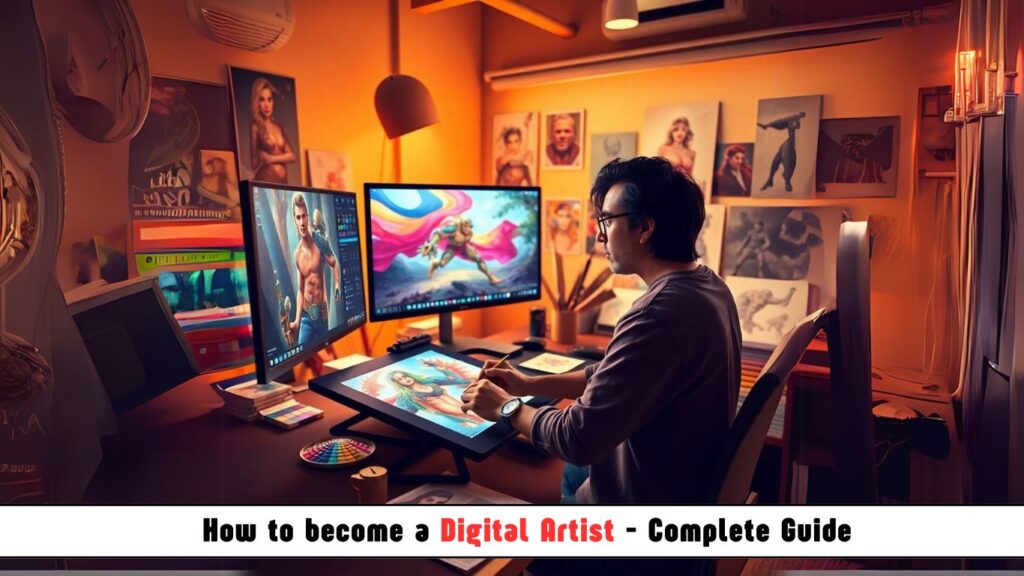
Introduction: The Digital Art Revolution
Gone are the days when artists were confined to physical canvases. Today’s Digital Artists blend traditional artistry with cutting-edge technology to create stunning visuals for films, games, advertising, and social media. From concept art for Marvel movies to NFT collections selling for millions, digital art has become one of the most dynamic creative fields.
This comprehensive guide covers everything you need to know about becoming a digital artist – from its pixelated beginnings to today’s AI-assisted workflows and future career opportunities.
1. What is a Digital Artist?
A Digital Artist creates visual content using digital tools rather than traditional media. Key characteristics:
- Software-based creation (Photoshop, Procreate, Blender)
- Diverse applications (Entertainment, marketing, fine art)
- Hybrid skills (Art fundamentals + technical proficiency)
Common Specializations:
- Concept Art
- Digital Illustration
- 3D Modeling
- Motion Graphics
- Matte Painting
- NFT Art
2. The History of Digital Art
Early Experiments (1950s-1980s)
- 1952: First digital image created on oscilloscope
- 1963: Ivan Sutherland’s Sketchpad (first digital drawing program)
- 1984: Macintosh introduces accessible digital art tools
The Desktop Revolution (1990s)
- 1990: Photoshop 1.0 launches
- 1995: Toy Story (first fully CGI feature film)
- 1998: Wacom tablets bring natural drawing to computers
Modern Era (2000s-Present)
- 2007: iPhone sparks mobile digital art
- 2010: Instagram creates new art distribution channels
- 2021: Beeple’s NFT sells for $69 million
- 2023: AI art tools like Midjourney enter mainstream
3. Roles and Responsibilities
Digital artists wear many hats depending on their specialization:
Concept Artist
- Creates early visual prototypes for games/films
- Works closely with directors and designers
- Requires strong storytelling through visuals
3D Modeler
- Builds digital assets for animation/VFX
- Specializes in characters, environments, or props
- Needs expertise in ZBrush/Maya/Blender
Illustrator
- Creates digital paintings and designs
- Works in publishing, advertising, or freelance
- Masters tools like Procreate and Photoshop
Motion Graphics Artist
- Designs animated graphics for videos
- Combines art with After Effects skills
- Creates UI animations, explainer videos
NFT Artist
- Produces blockchain-based digital art
- Understands crypto platforms and smart contracts
- Builds communities around collections
4. Digital Artist Salary Guide (2024)
Salaries vary by specialization, experience, and location:
| Position | Entry-Level | Mid-Career | Senior |
|---|---|---|---|
| Concept Artist | $45,000 | $75,000 | $120,000+ |
| 3D Modeler | $50,000 | $80,000 | $110,000+ |
| Illustrator | $35,000 | $60,000 | $90,000+ |
| Motion Graphics | $48,000 | $72,000 | $100,000+ |
| NFT Artist* | Highly variable (Some earn millions, most supplement income) |
*NFT earnings are project-based and unpredictable
Top-Paying Industries:
- AAA Game Studios
- Hollywood VFX Houses
- Tech Companies (UI/UX)
- Advertising Agencies
5. Essential Skills & Tools
Technical Skills
- 2D: Photoshop, Procreate, Illustrator
- 3D: Blender, Maya, ZBrush
- Animation: After Effects, Spine
- Emerging: AI tools (Midjourney, Stable Diffusion)
Art Fundamentals
- Anatomy and perspective
- Color theory and composition
- Lighting and texture
Business Skills
- Personal branding
- Client communication
- Contract negotiation
6. Education Paths
Formal Education
- BFA in Digital Arts
- Animation/Game Design degrees
- Specialized school (Gnomon, ArtCenter)
Alternative Routes
- Online courses (Schoolism, CGMA)
- YouTube tutorials (Proko, FlippedNormals)
- Mentorship programs
Self-Taught Essentials
- Daily drawing practice
- Software mastery
- Portfolio development
7. Building Your Career
Step 1: Develop Core Skills
- 1 year of focused fundamentals study
- Master at least one software deeply
Step 2: Create a Portfolio
- 8-12 strong pieces
- Tailored to target industry
- Shows process (sketches → final)
Step 3: Gain Experience
- Freelance platforms (Upwork, Fiverr)
- Internships at studios
- Personal projects with deadlines
Step 4: Specialize
- Identify marketable niche
- Develop signature style
- Stay updated on industry trends
8. Future of Digital Art
Emerging Opportunities
- Metaverse Design: Virtual worlds need artists
- AI Collaboration: Artists directing AI tools
- Virtual Production: Real-time filmmaking
- Medical Visualization: Educational 3D models
Disruptive Technologies
- Generative AI art
- VR/AR creation tools
- Blockchain for art provenance
Long-Term Trends
- Increased demand for 3D skills
- More hybrid artist-technician roles
- Growth in interactive digital experiences
Conclusion: Your Digital Art Journey
The digital art field offers unprecedented opportunities for creative professionals willing to continuously learn and adapt. While competition is fierce, artists with strong fundamentals and specialized skills will thrive in our increasingly digital visual culture.
Action Steps to Start Today:
- Choose your primary software
- Set up a daily practice routine
- Build an online presence
- Connect with artist communities
Remember: Every master digital artist started with their first awkward tablet drawings. Your creative future is just a stylus tap away.













Post Comment